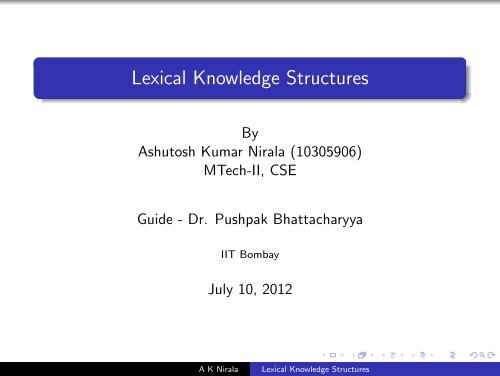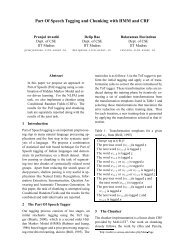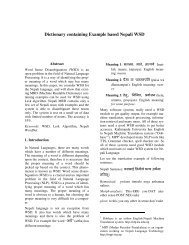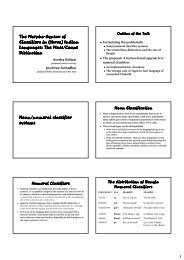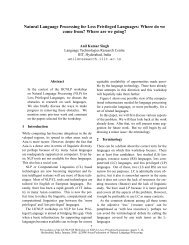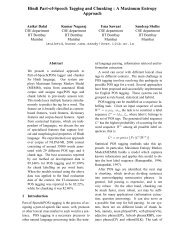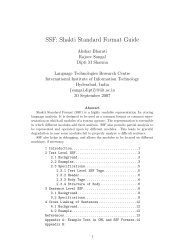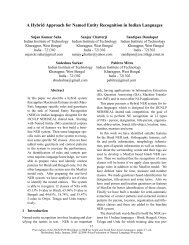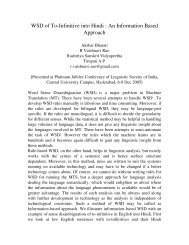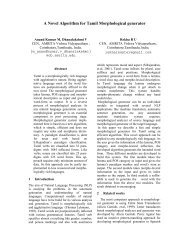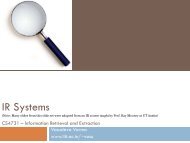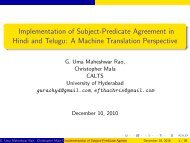Lexical Knowledge Structures
Lexical Knowledge Structures
Lexical Knowledge Structures
Create successful ePaper yourself
Turn your PDF publications into a flip-book with our unique Google optimized e-Paper software.
<strong>Lexical</strong> <strong>Knowledge</strong> <strong>Structures</strong><br />
By<br />
Ashutosh Kumar Nirala (10305906)<br />
MTech-II, CSE<br />
Guide - Dr. Pushpak Bhattacharyya<br />
IIT Bombay<br />
July 10, 2012<br />
A K Nirala<br />
<strong>Lexical</strong> <strong>Knowledge</strong> <strong>Structures</strong>
Overview<br />
Need of <strong>Lexical</strong> resources.<br />
Making computers smarter.<br />
From AI-NLP perspective.<br />
Providing information.<br />
<strong>Lexical</strong> <strong>Knowledge</strong> <strong>Structures</strong>.<br />
A K Nirala<br />
<strong>Lexical</strong> <strong>Knowledge</strong> <strong>Structures</strong>
SHRDLU (1971)<br />
A K Nirala<br />
<strong>Lexical</strong> <strong>Knowledge</strong> <strong>Structures</strong>
SHRDLU, Demo by Terry Winograd at the MIT AI Lab<br />
(1971)<br />
The dialog that was used as a SHRDLU demo (in 1971): 1<br />
1 taken from : http://hci.stanford.edu/winograd/shrdlu/index.html<br />
A K Nirala<br />
<strong>Lexical</strong> <strong>Knowledge</strong> <strong>Structures</strong>
SHRDLU : a success story.<br />
Considered a significant step forward in NLP, as it combines<br />
models of human linguistic<br />
reasoning methods in the language understanding process.<br />
But so far has not been extended further.<br />
Works in simple, logical, and closed domain.<br />
Can-not handle hypothesis.<br />
Things are totaly abstracted.<br />
A K Nirala<br />
<strong>Lexical</strong> <strong>Knowledge</strong> <strong>Structures</strong>
<strong>Lexical</strong> <strong>Knowledge</strong> Networks<br />
Cyc project, started 1984 by Doug Lenat<br />
Goal is to capture all facts that the average person knows.<br />
350 man-years of effort estimated<br />
ConceptNet, started 1999, by MIT Media Lab<br />
In 2000 become a World Wide Web collaborative project.<br />
By 2004 had 300 000 concepts and 1.6 million relations.<br />
English WordNet, started 1985, by direction of George A.<br />
Miller<br />
<strong>Lexical</strong> database that could be searched conceptually.<br />
YAGO ontologies 2007<br />
Combines WordNet and Wikipedia.<br />
Made by crawling Wikipedia in January 2007.<br />
VerbOcean<br />
Contains relations between verbs.<br />
Relations captured semi-automatically.<br />
A K Nirala<br />
<strong>Lexical</strong> <strong>Knowledge</strong> <strong>Structures</strong>
ConceptNet<br />
ConceptNet<br />
A K Nirala<br />
<strong>Lexical</strong> <strong>Knowledge</strong> <strong>Structures</strong>
ConceptNet [4]<br />
A common sense knowledge base from MIT Media Lab.<br />
Aims to capture facts,<br />
-which enables humans in day to day activity.<br />
by cpaturing relations between concepts<br />
Started in 1999,<br />
Contributed by 1000s of people.<br />
via OMCS web interface. (Till ConceptNet 4.orc4)<br />
in ConceptNet 5, English Wikipedia, WordNet and many other.<br />
A K Nirala<br />
<strong>Lexical</strong> <strong>Knowledge</strong> <strong>Structures</strong>
Typical relations in concept net<br />
A K Nirala<br />
<strong>Lexical</strong> <strong>Knowledge</strong> <strong>Structures</strong>
Relations in ConceptNet, K-Lines<br />
There are 20 different relations (as in ConceptNet2.1)<br />
K lines 2 (1.25 million assertion)<br />
ConceptuallyRelatedTo ‘bad breath’‘mint’‘f=4;i=0;’<br />
ThematicKLine ‘wedding dress’‘veil’‘f=9;i=0;’<br />
SuperThematicKLine ‘western civilisation’‘civilisation’<br />
‘f=0;i=12;’<br />
2 [5] : Marvin Minsky : A Theory of Memory<br />
A K Nirala<br />
<strong>Lexical</strong> <strong>Knowledge</strong> <strong>Structures</strong>
Relations in ConceptNet Agents, Things<br />
AGENTS (104 000 assertions)<br />
CapableOf ‘dentist’‘pull tooth’‘f=4;i=0;‘<br />
THINGS (52 000 assertions)<br />
IsA (Hyponym) ‘horse’‘mammal’‘f=17;i=3;‘<br />
PartOf (Meronym) ‘butterfly’‘wing’‘f=5;i=1;‘<br />
DefinedAs (Gloss) ‘meat’‘flesh of animal’‘f=2;i=1;‘<br />
MadeOf<br />
‘bacon’‘pig’‘f=3;i=0;‘<br />
PropertyOf ‘fire’‘dangerous’‘f=17;i=1;‘<br />
A K Nirala<br />
<strong>Lexical</strong> <strong>Knowledge</strong> <strong>Structures</strong>
Relations in ConceptNet Events, Spatial, Causal<br />
EVENTS (38 000 assertions)<br />
PrerequisiteEventOf ‘eat breakfast’‘wake up in morning’<br />
‘f=2;i=0;’<br />
FirstSubeventOf ‘start fire’‘light match’‘f=2;i=3;’<br />
SubeventOf ‘eat breakfast’‘chew food’‘f=2;i=0;’<br />
LastSubeventOf ‘attend classical concert’‘applaud’‘f=2;i=1;’<br />
LocationOf<br />
EffectOf<br />
DesirousEffectOf<br />
SPATIAL (36 000 assertions)<br />
‘army’‘in war’‘f=3;i=0;’<br />
CAUSAL (17 000 assertions)<br />
‘view video’‘entertainment’‘f=2;i=0;’<br />
‘sweat’‘take shower’‘f=3;i=1;’<br />
A K Nirala<br />
<strong>Lexical</strong> <strong>Knowledge</strong> <strong>Structures</strong>
Relations in ConceptNet Functional, Affective<br />
FUNCTIONAL (115 000 assertions)<br />
UsedFor ‘alarm clock’‘wake up’‘f=1;i =2;’<br />
CapableOfReceivingAction ‘drink’‘serve’‘f =0;i =14;’<br />
MotivationOf<br />
DesireOf<br />
AFFECTIVE (34 000 assertions)<br />
‘go to bed early’‘wake up in morning’<br />
‘f =3;i=0;’<br />
‘person’‘not be depressed’<br />
‘f=2;i=0;’<br />
A K Nirala<br />
<strong>Lexical</strong> <strong>Knowledge</strong> <strong>Structures</strong>
ConceptNet<br />
Development Process of ConceptNet<br />
A K Nirala<br />
<strong>Lexical</strong> <strong>Knowledge</strong> <strong>Structures</strong>
Development Process of ConceptNet via OMCS<br />
<strong>Knowledge</strong> acquisition from the general public[7].<br />
Extraction & Normalisation phase.<br />
Relaxation phase.<br />
A K Nirala<br />
<strong>Lexical</strong> <strong>Knowledge</strong> <strong>Structures</strong>
<strong>Knowledge</strong> acquisition from the general public, OMCS1<br />
People not having special training in NLP or AI.<br />
CycL like Cyc can not be used<br />
So a context is given, like:-<br />
Bob had a cold. Bob went to a doctor<br />
knowledge helpful to understand it was collected.<br />
Bob was feeling sick.<br />
The doctor made Bob feel better.<br />
The doctor might have worn a white coat.<br />
A K Nirala<br />
<strong>Lexical</strong> <strong>Knowledge</strong> <strong>Structures</strong>
Extraction phase<br />
Relations are extracted by matching patterns like<br />
[a | an | the] N1 (is | are) [a | an | the] [A1] N2<br />
→ Dogs are mammals<br />
→ Hurricanes are powerful storms<br />
gives<br />
Dog IsA mammal<br />
Hurricane IsA powerful storm<br />
N1 requires [a | an] [A1] N2<br />
→ Writing requires a pen<br />
→ Bathing requires water<br />
gives:-<br />
pen UsedFor writing<br />
Water UsedFor bathing<br />
A K Nirala<br />
<strong>Lexical</strong> <strong>Knowledge</strong> <strong>Structures</strong>
Relaxation phase<br />
Duplicate assertions are merged and count is maintained.<br />
IsA relation is used to lift the concepts<br />
(IsA ‘apple’ ‘fruit’)<br />
(IsA ‘banana’ ‘fruit’)<br />
(IsA ‘peach’ ‘fruit’)<br />
AND<br />
(PropertyOf ‘apple’ ‘sweet’)<br />
(PropertyOf ‘banana’ ‘sweet’)<br />
(PropertyOf ‘peach’ ‘sweet’)<br />
IMPLIES<br />
(PropertyOf ‘fruit’ ‘sweet’)<br />
A K Nirala<br />
<strong>Lexical</strong> <strong>Knowledge</strong> <strong>Structures</strong>
Relaxation phase (contd.)<br />
SuperThematicKLine relations capturing generalization are<br />
produced.<br />
WordNet and FrameNet’s verb synonym sets and<br />
class-hierarchies are used.<br />
(SuperThematicKLine ‘buy food’ ‘buy’)<br />
(SuperThematicKLine ‘purchase food’ ‘buy’)<br />
If noun phrase have adjectival modifier<br />
and is repeated<br />
then PropertyOf relation is inferd.<br />
[(IsA ‘apple’ ‘red round object’);<br />
(IsA ‘apple’ ‘red fruit’);]<br />
It implies (PropertyOf ‘apple’ ‘red’);<br />
A K Nirala<br />
<strong>Lexical</strong> <strong>Knowledge</strong> <strong>Structures</strong>
Evaluation of accumulated data<br />
1% of the OMCS-1 corpus was manually evaluated.<br />
Evaluating the accumulated database<br />
7.3 7%<br />
11.4 11%<br />
Nonstandard (additional<br />
material needed)<br />
Garbage<br />
Rated<br />
81.1 81%<br />
A K Nirala<br />
<strong>Lexical</strong> <strong>Knowledge</strong> <strong>Structures</strong>
Evaluation of accumulated data<br />
8 judges rated items on 4 attributes<br />
Scored on 1 to 5<br />
where score 5 means total agreement with the attribute.<br />
Generality : is item too specific<br />
score 5 : Dew is wet<br />
score 1 : Eritrea is part of Africa<br />
Truth<br />
Score 1 : Someone can be at infinity<br />
Neutrality : is it personal opinion<br />
Score 1 : Idiots are obsessed with star trek.<br />
Sense : does the item makes sens<br />
Score 1 : Cows can low quietly.!!<br />
A K Nirala<br />
<strong>Lexical</strong> <strong>Knowledge</strong> <strong>Structures</strong>
Manual Rating<br />
Rating, with increasing relevance [7].<br />
Avg Score<br />
Generality : 3.26<br />
Truth : 4.28<br />
Neutrality : 4.42<br />
Sense : 4.55<br />
A K Nirala<br />
<strong>Lexical</strong> <strong>Knowledge</strong> <strong>Structures</strong>
<strong>Knowledge</strong> acquisition from the general public, OMCS2<br />
Following observations were made<br />
Templates are efficient.<br />
Participants want to enter what is in there mind.<br />
Participants wished interaction, access and modification to<br />
data.<br />
A K Nirala<br />
<strong>Lexical</strong> <strong>Knowledge</strong> <strong>Structures</strong>
Workflow model for acquisition<br />
User browse database<br />
Finds item, assoc with a template, of interest.<br />
On click on template a form is presented to user.<br />
Examples are also shown<br />
User fills the form and submit.<br />
System display the inferred relations.<br />
User can accept or reject them.<br />
A K Nirala<br />
<strong>Lexical</strong> <strong>Knowledge</strong> <strong>Structures</strong>
OMCS web interface<br />
A sample web interface 3 .<br />
3 Picture taken from A kid’s Open Mind Common Sense [6]<br />
A K Nirala<br />
<strong>Lexical</strong> <strong>Knowledge</strong> <strong>Structures</strong>
Feedback and Inference<br />
Method 1 : Analogies over concept<br />
Slots filled in the template are searched for other templates.<br />
A mother can have a baby gives<br />
A mother can hold her baby<br />
Then other relations matching this newly found template are<br />
searched<br />
A small girl can hold her small dog<br />
For each match, slots values are replaced with the found one.<br />
A small girl can have a small dog<br />
If user finds it correct he may confirm this.<br />
A K Nirala<br />
<strong>Lexical</strong> <strong>Knowledge</strong> <strong>Structures</strong>
Feedback and Inference (contd.)<br />
Method 2 : Analogies over Relations<br />
Template are searched for other concepts.<br />
A mother can have a baby gives<br />
A child can have a goldfish<br />
Then for new slots values other Template are searched.<br />
A child can take care of goldfish<br />
For each match, slots values are replaced with entered one.<br />
A mother can take care of a child<br />
If user finds it correct he may confirm this.<br />
A K Nirala<br />
<strong>Lexical</strong> <strong>Knowledge</strong> <strong>Structures</strong>
Feedback and Inference (contd.)<br />
Method 3 : Analogies as Inference Rules<br />
It first generates a list of inference rules.<br />
For this programs first tries to find a cycle.<br />
Rules are automatically extracted using OMCS-1 database.<br />
More matches ⇒ better rules.<br />
If two links for rules are discovered program can infer third<br />
User enters : Bats like darkness<br />
If db has : You might find bats near cave interiors<br />
and the corresponding rule, then it will infer<br />
Cave interior is a darkness<br />
A K Nirala<br />
<strong>Lexical</strong> <strong>Knowledge</strong> <strong>Structures</strong>
More user inputs<br />
Clarification by suggesting common words as replacement.<br />
common words extracted as frequency from OMCS-1 corpus.<br />
Replacement using synonym dictionaries.<br />
Users are prompted for WSD.<br />
Automated methods suggest sense tags.<br />
User only need to provide one or two senses.<br />
Concepts are linked to topic.<br />
Linking maintained as topic vectors.<br />
Facilitates wide knowledge retrieval.<br />
A K Nirala<br />
<strong>Lexical</strong> <strong>Knowledge</strong> <strong>Structures</strong>
ConceptNet5<br />
ConceptNet5 contains concepts from a no of sources. 4<br />
4 taken from : http://conceptnet5.media.mit.edu/<br />
A K Nirala<br />
<strong>Lexical</strong> <strong>Knowledge</strong> <strong>Structures</strong>
ConceptNet5<br />
ConceptNet5 released on 2011 October 28<br />
ConceptNet5.1 released on 2012 April 30<br />
Multiple sources.<br />
Concepts in other languages.<br />
Available as full download and<br />
Core download without relations from other resources.<br />
A K Nirala<br />
<strong>Lexical</strong> <strong>Knowledge</strong> <strong>Structures</strong>
Graphical structure of ConceptNet5<br />
Available in multiple formats.<br />
Hypergraph, edges about relations.<br />
justified by other assertions, knowledge sources or processes.<br />
each justification have positive or negative weight.<br />
Negative means not true.<br />
Relations could be interlingual<br />
or automatically extracted relations, specific to a language.<br />
A K Nirala<br />
<strong>Lexical</strong> <strong>Knowledge</strong> <strong>Structures</strong>
URI hierarchy<br />
Uniform Resource Identifier.<br />
eg : http://conceptnet5.media.mit.edu/web/c/en/gandhi<br />
every object has URI.<br />
standard place to look it up.<br />
meaningful<br />
for edges it is hash - for uniqueness.<br />
A K Nirala<br />
<strong>Lexical</strong> <strong>Knowledge</strong> <strong>Structures</strong>
URI hierarchy (contd)<br />
Different kinds distinguished from first element.<br />
/a/ assertions.<br />
/c/ concepts (words, phrases from a language).<br />
/ctx/ context in which assertion is true.<br />
/d/ datasets.<br />
/e/ unique id for edges.<br />
/l/ license for redistributing information in an edge.<br />
/l/CC/By Creative Commons.<br />
/l/CC/By-SA Attribution-ShareAlike.<br />
/r/ language independent relation like /r/IsA<br />
/s/ knowledge sources<br />
human contributors, Web sites or automated processes.<br />
A K Nirala<br />
<strong>Lexical</strong> <strong>Knowledge</strong> <strong>Structures</strong>
Concept URIs<br />
Each concept has minimum three components<br />
/c/ to indicate it is a concept.<br />
language part, ISO abbreviated.<br />
concept text.<br />
Optional fourth component for POS<br />
/c/en/read/v<br />
Optional fifth component for a particular sense.<br />
/c/en/read/v/interpret something that is written or printed<br />
A K Nirala<br />
<strong>Lexical</strong> <strong>Knowledge</strong> <strong>Structures</strong>
Fields in ConceptNet5.1<br />
{<br />
}<br />
"endLemmas": "fruit",<br />
"rel": "/r/IsA",<br />
"end": "/c/en/fruit",<br />
"features": [<br />
"/c/en/apple /r/IsA -",<br />
"/c/en/apple - /c/en/fruit",<br />
"- /r/IsA /c/en/fruit"<br />
],<br />
"license": "/l/CC/By",<br />
"sources": [<br />
"/s/rule/sum_edges"<br />
],<br />
"startLemmas": "apple",<br />
"text": [<br />
"fruit",<br />
"apple"<br />
],<br />
"uri": "/a/[/r/IsA/,/c/en/apple/,/c/en/fruit/]",<br />
"weight": 244.66679999999999,<br />
"dataset": "/d/conceptnet/5/combined-core",<br />
"start": "/c/en/apple",<br />
"score": 1049.3064999999999,<br />
"context": "/ctx/all",<br />
"timestamp": "2012-05-25T03:41:00.346Z",<br />
"nodes": [<br />
"/c/en/fruit",<br />
"/c/en/apple",<br />
"/r/IsA"<br />
],<br />
"id": "/e/3221407ec935683f2b7079b0495f164e1e321cd4"<br />
A K Nirala<br />
<strong>Lexical</strong> <strong>Knowledge</strong> <strong>Structures</strong>
ConceptNet5.1 WEB API<br />
Lookup : When URI is known.<br />
Example<br />
http://conceptnet5.media.mit.edu/data/5.1/c/en/apple<br />
Search : when URI is not known<br />
Performed with base URL + criteria (in GET)<br />
BASE URL :<br />
http://conceptnet5.media.mit.edu/data/5.1/search<br />
WITH criteria :<br />
http://conceptnet5.media.mit.edu/data/5.1/searchtext=apple<br />
Association : for finding similar concepts.<br />
A K Nirala<br />
<strong>Lexical</strong> <strong>Knowledge</strong> <strong>Structures</strong>
Arguments for Search<br />
Passed as GET parameter<br />
{id, uri, rel, start, end, context, dataset, license} :<br />
matches start of the field.<br />
nodes : if start of any node matches.<br />
text, {startLemmas, endLemmas, relLemmas} : matches<br />
anywhere.<br />
surfaceText matches surface text but is case sensitive<br />
minWeight, limit, offset<br />
features : needs exact match.<br />
filter :<br />
core : no ShareAlike resources included<br />
core-assertions : one result per assertion<br />
A K Nirala<br />
<strong>Lexical</strong> <strong>Knowledge</strong> <strong>Structures</strong>
API for Association<br />
BASE URL :<br />
http://conceptnet5.media.mit.edu/data/5.1/assoc<br />
SOURCE CONCEPT : /list/<br />
multiple terms are ‘,’separated.<br />
@ specifies a weight (relative to other elements)<br />
GET PARAMETERS<br />
limit=n<br />
filter=URI<br />
http://conceptnet5.media.mit.edu/data/5.1/assoc<br />
/list/en/cat,food@0.5limit=1&filter=/c/en/dog<br />
A K Nirala<br />
<strong>Lexical</strong> <strong>Knowledge</strong> <strong>Structures</strong>
ConceptNet<br />
Applications Developed using ConceptNet<br />
A K Nirala<br />
<strong>Lexical</strong> <strong>Knowledge</strong> <strong>Structures</strong>
GOOSE 2004<br />
Goal-Oriented Search Engine With Commonsense 5<br />
5 taken from : http://agents.media.mit.edu/projects/goose/<br />
A K Nirala<br />
<strong>Lexical</strong> <strong>Knowledge</strong> <strong>Structures</strong>
GOOSE : working [3]<br />
Parses the query into semantic frame.<br />
Classify into common sense sub-domain.<br />
Reformulation<br />
Apply reasoning using inference chain.<br />
Heuristically guided.<br />
Termination on application-level rule.<br />
extract the reformulated search term.<br />
Search on commercial search engine.<br />
Re-ranking<br />
Based on weighted concepts.<br />
A K Nirala<br />
<strong>Lexical</strong> <strong>Knowledge</strong> <strong>Structures</strong>
GOOSE : a scenario [3]<br />
Goal : I want help solving this problem<br />
and query, my golden retriever has a cough<br />
Problem Attribute [cough]<br />
Parsing gives<br />
Problem Object [golden retriever]<br />
commonsense sub-domain classified : animals with the chain<br />
A golden retriever is a kind of dog.<br />
A dog may be a kind of pet.<br />
Something that coughs indicates it is sick.<br />
Veterinarians can solve problems with pets that are sick.<br />
Veterinarians are locally located.<br />
The reformulated search is<br />
Veterinarians, Cambridge MA<br />
Location obtained from user profile. Page containing concepts<br />
closer to veterinarians is ranked high<br />
A K Nirala<br />
<strong>Lexical</strong> <strong>Knowledge</strong> <strong>Structures</strong>
GOOSE Results [3]<br />
Search Task no of Avg. score Avg. score<br />
successful GOOSE Google<br />
inferences<br />
Solve household problem 7/8 6.1 3.5<br />
Find someone online 4/8 4.0 3.6<br />
Research a product 1/8 5.9 6.1<br />
Learn more about 5/8 5.3 5.0<br />
A K Nirala<br />
<strong>Lexical</strong> <strong>Knowledge</strong> <strong>Structures</strong>
Other applications [4]<br />
Commonsense ARIA<br />
Suggests photos while writing email or Web pages.<br />
Uses manually marked tags.<br />
Add tags when photo is used.<br />
Use common sense for better search [7]<br />
Given : Susan is Jane’s sister<br />
Commonsense : in a wedding, the bridesmaid is often the<br />
sister of the bride<br />
Jain’s photo can be retrieved if tag is<br />
Susan and her bridesmaids<br />
MAKEBELIEVE : interactively invents a story.<br />
Uses causal projection chains to create storyline.<br />
GloBuddy : dynamic foreign language phrasebook.<br />
Translates related concepts.<br />
eg : I am at a restaurant generates<br />
people, waiter, chair, eat with translations.<br />
Suggesting words in mobile text-messages by inferring context<br />
A K Nirala<br />
<strong>Lexical</strong> <strong>Knowledge</strong> <strong>Structures</strong>
YAGO : Yet Another Great Ontology<br />
YAGO : A Large Ontology from Wikipedia and<br />
WordNet 6<br />
6 [9] : Fabian M.Suchanek, Gjergji Kasneci, Gerhard Weikum<br />
A K Nirala<br />
<strong>Lexical</strong> <strong>Knowledge</strong> <strong>Structures</strong>
Information Extraction<br />
Google searches web pages.<br />
A K Nirala<br />
<strong>Lexical</strong> <strong>Knowledge</strong> <strong>Structures</strong>
YAGO ontology<br />
Combines high coverage with high quality.<br />
Uses infoboxes and category of Wikipedia.<br />
Overall precision of 95%<br />
decidable.<br />
YAGO model uses extension to RDFS.<br />
Expresses entities, facts, relation between facts and properties<br />
of relation.<br />
A K Nirala<br />
<strong>Lexical</strong> <strong>Knowledge</strong> <strong>Structures</strong>
YAGO data model, few examples<br />
Elvis won a Grammy Award<br />
(Elvis Presley, hasWonPrize, Grammy Award)<br />
words are entities as well.<br />
Quotes to distinguish from other entities.<br />
(“Elvis”, means, Elvis Presley)<br />
Allows to deal with synonyms and ambiguity<br />
(“Elvis”, means, Elvis Costello)<br />
Similar entities are grouped into classes.<br />
(Elvis Presley, type, singer)<br />
Classes & relations are entities as well.<br />
(singer, subClassOf, person)<br />
(subclassOf, type, atr)<br />
A K Nirala<br />
<strong>Lexical</strong> <strong>Knowledge</strong> <strong>Structures</strong>
n-ary relations<br />
Expressing multiple relations 7<br />
Every edge is given an edge identifier.<br />
#1 (Sam, is a, scientist)<br />
#2 (#1, since, 1998)<br />
#3 (#1, source, Wikipedia)<br />
7 picture taken from presentation by Fabian M. Suchanek<br />
A K Nirala<br />
<strong>Lexical</strong> <strong>Knowledge</strong> <strong>Structures</strong>
YAGO Model: Formal view<br />
common entities : which are neither facts nor relations.<br />
E.g.# : singer, person, Elvis Presley<br />
individuals : common entities which are not classes. E.g.# :<br />
Elvis Presley<br />
Its a reification graph. defined over<br />
set of common entities nodes C,<br />
set of edge identifiers I<br />
set of relation names R<br />
reification graph is an injective total function<br />
G C,I ,R : I → (C ∪ I ) × R × (C ∪ I )<br />
A K Nirala<br />
<strong>Lexical</strong> <strong>Knowledge</strong> <strong>Structures</strong>
Semantics<br />
Any YAGO ontologies must have following relations (R)<br />
type : (Elvis Presley, type, singer)<br />
subClassOf : (singer, subClassOf, person)<br />
domain : (subClassOf, domain, class)<br />
range : (subRelationOf, range, relation)<br />
subRelationOf : (fatherOf, subRelationOf, parentOf)<br />
Common entities (C) must contain the classes<br />
entity<br />
class<br />
relation<br />
atr : acyclic transitive relation<br />
A K Nirala<br />
<strong>Lexical</strong> <strong>Knowledge</strong> <strong>Structures</strong>
Classes for all literals<br />
Classes for all literals 8 .<br />
8 Graph from [10] : YAGO report 2007<br />
A K Nirala<br />
<strong>Lexical</strong> <strong>Knowledge</strong> <strong>Structures</strong>
Semantics : Rewrite rule<br />
{f 1 , ..., f n } ↩→ f<br />
i.e., given facts f 1 to f n , fact f is infered.<br />
Φ ↩→ (domain, RANGE, class)<br />
Φ ↩→ (domain, DOMAIN, relation)<br />
i.e., range for domain (which is a relation) will be a class.<br />
But, “domain”relation can only be applied to a relation.<br />
So, any relation‘s domain will always be some class.<br />
E.g.# (isCitizenOf, domain, person)<br />
Φ ↩→ (range, RANGE, class)<br />
Φ ↩→ (range, DOMAIN, relation)<br />
E.g.# (isCitizenOf, range, country)<br />
A K Nirala<br />
<strong>Lexical</strong> <strong>Knowledge</strong> <strong>Structures</strong>
Semantics : Rewrite rule (contd.)<br />
Φ ↩→ (subClassOf, DOMAIN, class)<br />
Φ ↩→ (subClassOf, RANGE, class)<br />
Φ ↩→ (subClassOf, TYPE, atr)<br />
E.g1. #<br />
(NonNegInteger, subClassOf, Integer) &<br />
(Integer, subClassOf, Number)<br />
So : (NonNegInteger, subClassOf, Number)<br />
E.g2. #<br />
(wordnet carnival 100511555, subClassOf,<br />
wordnet festival 100517728) &<br />
(wordnet festival 100517728, subClassOf,<br />
wordnet celebration 100428000)<br />
So : (wordnet carnival 100511555, subClassOf,<br />
wordnet celebration 100428000)<br />
A K Nirala<br />
<strong>Lexical</strong> <strong>Knowledge</strong> <strong>Structures</strong>
Semantics : Rewrite rule (contd.)<br />
Φ ↩→ (type, RANGE, class)<br />
Φ ↩→ (subRelationOf, DOMAIN, relation)<br />
Φ ↩→ (subRelationOf, RANGE, relation)<br />
Φ ↩→ (subRelationOf, TYPE, atr)<br />
E.g. #<br />
(happenedOnDate, subRelationOf, startedOnDate) &<br />
(startedOnDate, subRelationOf, startsExistingOnDate)<br />
So :<br />
(happenedOnDate, subRelationOf, startsExistingOnDate)<br />
For literal class for each edge X −→ Y<br />
Φ ↩→ (X, subClassOf, Y )<br />
A K Nirala<br />
<strong>Lexical</strong> <strong>Knowledge</strong> <strong>Structures</strong>
Semantics : Rewrite rule (contd)<br />
Given<br />
r, r 1 , r 2 ∈ R, where<br />
r, r 1 ≠ type, and<br />
r, r 2 ≠ subRelationOf<br />
x, y, c, c 1 , c 2 ∈ I ∪ C ∪ R, where<br />
c, c 2 ≠ atr<br />
Then,<br />
{(r 1 , subRelationOf, r 2 ), (x, r 1 , y)} ↩→ (x, r 2 , y)<br />
E.g.# : {(motherOf , subRelationOf, parentOf),<br />
(Kunti , motherOf, Arjun)} ↩→<br />
(Kunti , parentOf, Arjun)<br />
{(r, type, atr), (x, r, y), (y, r, z)} ↩→ (x, r, z)<br />
E.g1. #<br />
{(NonNegInteger, subClassOf, Integer),<br />
(Integer, subClassOf, Number)} ↩→<br />
So : (NonNegInteger, subClassOf, Number)<br />
A K Nirala<br />
<strong>Lexical</strong> <strong>Knowledge</strong> <strong>Structures</strong>
Semantics : Rewrite rule (contd)<br />
{(r, domain, c), (x, r, y)} ↩→ (x, type, c)<br />
E.g.#<br />
{(Sonia Gandhi, isCitizenOf, India),<br />
(isCitizenOf, domain, person)} ↩→<br />
(Sonia Gandhi, type, person)<br />
{(r, range, c), (x, r, y)} ↩→ (y, type, c)<br />
E.g.#<br />
{(Sonia Gandhi, isCitizenOf, India),<br />
(isCitizenOf, range, country)} ↩→<br />
(India, type, country)<br />
{(x, type, c 1 ), (c 1 , subClassOf, c 2 )} ↩→ (x, type, c 2 )<br />
E.g.#<br />
{ (Elvis Presley, type, singer),<br />
(singer, subClassOf, person)} ↩→<br />
(Elvis Presley, type, person)<br />
A K Nirala<br />
<strong>Lexical</strong> <strong>Knowledge</strong> <strong>Structures</strong>
Theorems & Corollary<br />
Given F = (I ∪ C ∪ R) × R × (I ∪ C ∪ R)<br />
Theorem 1<br />
[Convergence of −→]<br />
Given a set of facts F ⊂ F , the largest set S with F −→ S is<br />
finite and unique.<br />
Corollary 1<br />
[Decidability]<br />
The consistency of a YAGO ontology is decidable.<br />
Theorem 2<br />
[Uniqueness of the Canonical Base]<br />
The canonical base of a consistent YAGO ontology is unique.<br />
Can be computed by greedily removing derivable facts.<br />
A K Nirala<br />
<strong>Lexical</strong> <strong>Knowledge</strong> <strong>Structures</strong>
Restrictions<br />
Can’t state : f is FALSE<br />
Primary relation of n-ary relation is always true.<br />
E.g Elvis was a singer from 1950 to 1977<br />
#1 : (Elvis, type, singer)<br />
#2 : (#1, during, 1950-1977)<br />
Intentional predicates (like believesThat) not possible<br />
A K Nirala<br />
<strong>Lexical</strong> <strong>Knowledge</strong> <strong>Structures</strong>
Sources for YAGO<br />
Sources and Information Extraction<br />
A K Nirala<br />
<strong>Lexical</strong> <strong>Knowledge</strong> <strong>Structures</strong>
Sources for YAGO<br />
WordNet<br />
Uses hypernyms/hyponyms relation<br />
Conceptually it is DAG in WordNet<br />
Wikipedia<br />
XML dump of Wikipedia<br />
categories.<br />
infobox.<br />
2,000,000 articles in english wikipedia (Nov 2007) YAGO.<br />
3,867,050 articles in english wikipedia (Feb. 2012) YAGO2.<br />
YAGO2 9 : geo-location information from Geonames 10<br />
9 YAGO2: Exploring and Querying World <strong>Knowledge</strong> in Time, Space,<br />
Context, and Many Languages<br />
10 from http://www.geonames.org/<br />
A K Nirala<br />
<strong>Lexical</strong> <strong>Knowledge</strong> <strong>Structures</strong>
Information Extraction<br />
Two steps (YAGO 1)<br />
Extraction from Wikipedia<br />
Quality Control.<br />
A K Nirala<br />
<strong>Lexical</strong> <strong>Knowledge</strong> <strong>Structures</strong>
Extraction from Wikipedia<br />
Page title is a candidate for individual.<br />
Infoboxes<br />
Albert Einstein<br />
- Each row has attribute value.<br />
- manual rules designed for 170 (200<br />
for YAGO2) frequent attributes<br />
E.g:<br />
relation : birthDate<br />
domain : person<br />
range : timeInterval<br />
Albert Einstein in 1921<br />
A K Nirala<br />
<strong>Lexical</strong> <strong>Knowledge</strong> Residence <strong>Structures</strong><br />
Born 14 March 1879<br />
Ulm, Kingdom of<br />
Württemberg, German Empire<br />
Died 18 April 1955 (aged 76)<br />
Princeton, New Jersey, United<br />
States<br />
Germany, Italy, Switzerland,
Infoboxes<br />
Infobox type establishes the article entity class.<br />
E.g.# city infobox or person infobox.<br />
however, for Economy of a country, type is country.<br />
Each row can generate fact. (Arg 1 , relation, Arg 2 )<br />
Usually<br />
Arg 1 is article entity.<br />
relation determined by attribute.<br />
Arg 2 value of the attribute.<br />
Inverse attribute : entity becomes Arg 2<br />
E.g.#<br />
if attribute is official namee<br />
(entity hasOfficialName officialname)<br />
(officialname means entity)<br />
is not generated<br />
is generated instead<br />
A K Nirala<br />
<strong>Lexical</strong> <strong>Knowledge</strong> <strong>Structures</strong>
Infoboxes (contd)<br />
Infobox type may disambiguate meaning of attribute<br />
E.g.#<br />
length of car is in space<br />
length of song is in duration<br />
Value is parsed 11 as an instance of the range of target<br />
relation.<br />
Regular expression is uesd to parse numbers, dates and<br />
quantities<br />
Units of measurement normalized to ISO units.<br />
If range is not a literal class<br />
Wikipedia link is searched for entity.<br />
If search fails corresponding attribute is ignored.<br />
11 [8] LEILA, A link type parser is used<br />
A K Nirala<br />
<strong>Lexical</strong> <strong>Knowledge</strong> <strong>Structures</strong>
Types of facts<br />
Category system of Wikipedia is exploited<br />
Broadly categories could be<br />
conceptual categories, like<br />
Naturalized citizens of a country<br />
category for administrative purposes, like<br />
Articles with unsourced statements<br />
categories giving relational information like<br />
1879 births<br />
categories indicating thematic vicinity like<br />
Physics<br />
Only conceptual category can be class for individual.<br />
A K Nirala<br />
<strong>Lexical</strong> <strong>Knowledge</strong> <strong>Structures</strong>
Identifying Conceptual Category<br />
Administrative and relation categories are very low.<br />
less than a dozen<br />
manually excluded<br />
Shallow linguistic parsing splits category name<br />
Naturalized citizens of Japan is split as<br />
pre-modifier Naturalized<br />
head citizens<br />
post-modifier of Japan<br />
Plural head usually means conceptual category<br />
A K Nirala<br />
<strong>Lexical</strong> <strong>Knowledge</strong> <strong>Structures</strong>
Defining hierarchy of classes using WordNet<br />
Wikipedia categories are organized as DAG<br />
reflects only thematic structure of Wikipedia<br />
Elvis is in the category Grammy Awards<br />
So WordNet is used to define hierarchy over leaf category of<br />
Wikipedia.<br />
Each synset of WordNet becomes a class.<br />
Proper nouns are removed.<br />
Identified If<br />
WordNet sysnset has a common noun with Wikipedia page.<br />
Some information is lost only common nouns become class.<br />
subClassOf relation taken from hyponyms relation of WordNet<br />
A is subClassOf of B in YAGO, if<br />
synset A is hyponyms of synset B in WordNet<br />
A K Nirala<br />
<strong>Lexical</strong> <strong>Knowledge</strong> <strong>Structures</strong>
Defining hierarchy of classes using WordNet<br />
Lower classes of Wikipedia are connected to<br />
higher class of WordNet<br />
E.g.# American people in Japan is a subclass of person<br />
First category name is split in pre, head and post.<br />
pre American head people post in Japan<br />
head is stemmed to its singular form<br />
people → person<br />
If pre + head is in WordNet, desired class is achieved<br />
American person<br />
else, only head compound is searched<br />
The match with highest frequency sysnset is used.<br />
Exception like capital whose predominant sense in WordNet<br />
(financial asset) and Wikipedia (capital city) differed were<br />
manually corrected<br />
A K Nirala<br />
<strong>Lexical</strong> <strong>Knowledge</strong> <strong>Structures</strong>
Word heuristics<br />
A means relation is established between each word of<br />
WordNet synset<br />
E.g.# ( metropolis, means, city)<br />
Wikipedia redirects are used to give means relation<br />
E.g.# (Einstein, Albert, means, Albert Einstein)<br />
givenNameOf and familyNameOf relations are used using<br />
person names<br />
E.g.# (Albert, givenNameOf, Albert Einstein)<br />
E.g.# (Einstein, familyNameOf, Albert Einstein)<br />
A K Nirala<br />
<strong>Lexical</strong> <strong>Knowledge</strong> <strong>Structures</strong>
Category heuristics<br />
Relational category pages gives info about article<br />
E.g.# category Rivers in Germany ensures article entity has<br />
locatedIn relation with Germany.<br />
Regular expressions heuristics are used to get category names<br />
like Mountains | Rivers in (.*)<br />
Exploiting Language Category<br />
Categories like fr:Londers, and<br />
articles in them like the city of London<br />
gives relation<br />
London isCalled “Londres” inLanguage French<br />
A K Nirala<br />
<strong>Lexical</strong> <strong>Knowledge</strong> <strong>Structures</strong>
Quality Control & Type Checking<br />
Canonicalization<br />
Redirect Resolution:<br />
facts are obtained from infobox.<br />
Some links might be to the Wikipedia redirect pages.<br />
Such incorrect arguments are corrected.<br />
Duplicate facts are removed.<br />
more precise facts are kept<br />
E.g.# out of birthDate 1935-01-08 and 1935 only 1935-01-08<br />
is kept.<br />
Type Checking<br />
Reductive : facts are dropped if<br />
- class for an entity can not be detected.<br />
- first argument is not in the domain of the relation.<br />
Inductive : class for an entity is inferred<br />
- Works well with person - E.g.# if entity has birthDate then<br />
person is infered.<br />
A K Nirala<br />
<strong>Lexical</strong> <strong>Knowledge</strong> <strong>Structures</strong>
Storage<br />
Meta relations are stored like normal relation.<br />
URL for each individual is stored with describes<br />
foundIn relation are stored as witness.<br />
using relation stores technique of extraction.<br />
during relation stores the time of extraction.<br />
File format : model is independent of storage.<br />
simple text files are used as internal format<br />
Estimated accuracy between 1 and 0 is stored as well.<br />
XML version of text file and RDFS version are available.<br />
database schema is simply<br />
FACTS(faactId, arg1, relation, arg2, accuracy)<br />
Software to load in Oracle, Postgres or MySQL is provided.<br />
A K Nirala<br />
<strong>Lexical</strong> <strong>Knowledge</strong> <strong>Structures</strong>
Evaluating YAGO<br />
Randomly selected facts were presented to judges along with<br />
Wiki pages.<br />
pages were rated correct, incorrect or don’t know<br />
Only facts that stem from heuristics were evaluated<br />
Portion stems from WordNet is not evaluated.<br />
Non-heuristics relations like describes, foundIn are not<br />
evaluated.<br />
13 judges evaluated 5200 facts.<br />
A K Nirala<br />
<strong>Lexical</strong> <strong>Knowledge</strong> <strong>Structures</strong>
Precision of heuristics<br />
A K Nirala<br />
<strong>Lexical</strong> <strong>Knowledge</strong> <strong>Structures</strong>
YAGO 2 : Extensible Extraction Architecture<br />
Rules are interpreted - no longer hard coded.<br />
Becomes Addition YAGO2 facts.<br />
Factual rules<br />
Declarative translations of<br />
- all the manually defined exceptions and facts (total 60) in<br />
the code of YAGO1<br />
“capital” hasPreferredMeaning wordnet capital 108518505<br />
Litral types come with regular expression to match them.<br />
A K Nirala<br />
<strong>Lexical</strong> <strong>Knowledge</strong> <strong>Structures</strong>
YAGO 2 : Extensible Extraction Architecture<br />
Implication rules stored as<br />
“$1 $2 $3; $2 subpropertyOf $4;”implies “$1 $4 $3”<br />
Replacement rules for cleaning HTML tags, normalizing<br />
units etc<br />
“\{\{USA\}\}” replace “[[United States]]”<br />
Extraction rules stores regular expression rules 12 . for deriving<br />
fact.<br />
12 the regex is as defined for : regular expression syntax of java.util.regex<br />
A K Nirala<br />
<strong>Lexical</strong> <strong>Knowledge</strong> <strong>Structures</strong>
Information Extraction from different dimension<br />
Temporal Dimension: Assign begin and/or end of time<br />
spans to all entries, facts, events, etc.<br />
Geo-Spatial Dimension: assign location in space to all<br />
entities having a permanent location.<br />
GeoNames 13 is taped.<br />
Textual Dimension:<br />
relation like hasWikipediaAnchorText, hasCitationTitle, etc,<br />
are extracted from Wikipedia<br />
multi-lingual data from Universal Wordnet is added.<br />
13 from http://www.geonames.org/<br />
A K Nirala<br />
<strong>Lexical</strong> <strong>Knowledge</strong> <strong>Structures</strong>
Application<br />
YAGO : Application<br />
A K Nirala<br />
<strong>Lexical</strong> <strong>Knowledge</strong> <strong>Structures</strong>
YAGO in development of ontologies<br />
YAGO in development of ontologies 14<br />
14 picture taken from presentation of Besnik fetahu<br />
A K Nirala<br />
<strong>Lexical</strong> <strong>Knowledge</strong> <strong>Structures</strong>
Application of YAGO<br />
Querying<br />
Semantic Search : Basis for search engines like NAGA and<br />
ESTER<br />
NAGA uses YAGO KB for graph-based information retrieval.<br />
ESTER combines ontological search with text search.<br />
A K Nirala<br />
<strong>Lexical</strong> <strong>Knowledge</strong> <strong>Structures</strong>
Downloading YAGO<br />
Freely available at<br />
http://www.mpi-inf.mpg.de/yago-naga/yago/downloads.html<br />
A K Nirala<br />
<strong>Lexical</strong> <strong>Knowledge</strong> <strong>Structures</strong>
VerbOcean<br />
VerbOcean<br />
A K Nirala<br />
<strong>Lexical</strong> <strong>Knowledge</strong> <strong>Structures</strong>
VerbOcean<br />
Developed at University of Southern California.<br />
Captures semantic relation between 29,165 verb pairs [1].<br />
by mining the Web for Fine-Grained Semantic Verb Relation<br />
A K Nirala<br />
<strong>Lexical</strong> <strong>Knowledge</strong> <strong>Structures</strong>
Why VerbOcean<br />
WordNet provide relations between verbs<br />
but at a coarser level.<br />
No entailment of buy by sell.<br />
VerbOcean relates verbs<br />
doesn’t group them in classes.<br />
A K Nirala<br />
<strong>Lexical</strong> <strong>Knowledge</strong> <strong>Structures</strong>
Relations captured by VerbOcean<br />
Similarity<br />
produce :: create<br />
reduce :: restrict<br />
Strength : Subclass of Similarity<br />
intensity or completeness of change produced.<br />
taint :: poison<br />
permit :: authorize<br />
surprise :: startle<br />
startle :: shock<br />
A K Nirala<br />
<strong>Lexical</strong> <strong>Knowledge</strong> <strong>Structures</strong>
Relations captured by VerbOcean<br />
Antonymy<br />
Switching thematic roles of the verb<br />
buy :: sell<br />
lend :: borrow<br />
Between stative verbs<br />
live :: die<br />
differ :: equal<br />
Between siblings sharing a parent<br />
walk :: run<br />
Entailed by common verb<br />
fail :: succeed both entailed by try<br />
In happens-before relation<br />
damage :: repair<br />
wrap :: unwrap<br />
A K Nirala<br />
<strong>Lexical</strong> <strong>Knowledge</strong> <strong>Structures</strong>
Relations captured by VerbOcean<br />
Enablement between V 1 and V 2 if V 1 is accomplished by V 2 .<br />
assess :: review<br />
accomplish :: complete<br />
Happens-before : Related verbs refer to temporally disjoint<br />
intervals.<br />
detain :: prosecute<br />
enroll :: graduate<br />
schedule :: reschedule<br />
A K Nirala<br />
<strong>Lexical</strong> <strong>Knowledge</strong> <strong>Structures</strong>
Approach<br />
Associated verb pairs are extracted.<br />
Scored on Lexico-syntactic patterns.<br />
Semantic relation extracted on score of the patterns.<br />
Pruning.<br />
A K Nirala<br />
<strong>Lexical</strong> <strong>Knowledge</strong> <strong>Structures</strong>
Extracting Associated verb pairs<br />
1.5GB 15 newspaper corpus is considered.<br />
Verbs are associated if they link same sets of words.<br />
Corpus is searched 16 for verbs, relating same words.<br />
The path considered is : subject-verb-object.<br />
E.g.# Verbs associated with X solves Y (top 20)<br />
Y is solved by X<br />
X resolves Y<br />
X finds a solution to Y X tries to solve Y<br />
X deals with Y<br />
Y is resolved by X<br />
X addresses Y<br />
X seeks a solution to Y<br />
X does something about Y X solution to Y<br />
Y is resolved in X<br />
Y is solved through X<br />
X rectifies Y<br />
X copes with Y<br />
X overcomes Y<br />
X eases Y<br />
X tackles Y<br />
X alleviates Y<br />
X corrects Y<br />
X is a solution to Y<br />
X makes Y worse<br />
X irons out Y<br />
15 corpus consists of San Jose Mercury, Wall Street Journal and AP Newswire<br />
articles from the TREC-9 collection.<br />
16 using DIRT (Discovery of Inference Rules from Text) algorithm Lin and<br />
Pantel (2001)[2]<br />
A K Nirala<br />
<strong>Lexical</strong> <strong>Knowledge</strong> <strong>Structures</strong>
Lexico-syntactic patterns<br />
35 Lexico-syntactic pattern are used.<br />
Different Lexico-syntactic patterns indicate different relation.<br />
Manually selected,<br />
by examining, known semantic relation, verb pairs.<br />
Tense variations are accounted.<br />
Xed instantiates on sing and dance as sung and danced.<br />
Web is googled for each associated verb pair with these<br />
pattern.<br />
Patterns indicating narrow similarity<br />
X ie Y<br />
Xed ie Yed<br />
Kile, the software, has produced ie created this presentation.<br />
A K Nirala<br />
<strong>Lexical</strong> <strong>Knowledge</strong> <strong>Structures</strong>
Lexico-syntactic patterns (contd.)<br />
Patterns indicating broad similarity<br />
Xed and Yed<br />
to X and Y<br />
The enemy camp was bombarded and destroyed<br />
Patterns indicating strength<br />
X even Y<br />
Xed even Yed<br />
X and even Y<br />
Xed and even Yed<br />
Y or at least X<br />
Yed or at least Xed<br />
not only Xed but Yed<br />
not just Xed but Yed<br />
Better purchase or at least borrow this book<br />
A K Nirala<br />
<strong>Lexical</strong> <strong>Knowledge</strong> <strong>Structures</strong>
Lexico-syntactic patterns (contd.)<br />
Patterns indicating enablement<br />
Xed * by Ying the<br />
Xed * by Ying or<br />
to X * by Ying the<br />
to X * by Ying or<br />
You have an option to choose by selecting the values from a<br />
drop down.<br />
Patterns indicating antonymy<br />
either X or Y<br />
either Xs or Ys<br />
either Xed or Yed<br />
either Xing or Ying<br />
whether to X or Y<br />
Xed * but Yed<br />
to X * but Y<br />
People either hate or adore movies like Prometheus<br />
A K Nirala<br />
<strong>Lexical</strong> <strong>Knowledge</strong> <strong>Structures</strong>
Lexico-syntactic patterns (contd.)<br />
Patterns indicating happens-before<br />
to X and then Y<br />
to X * and then Y<br />
Xed and then Yed<br />
Xed * and then Yed<br />
to X and later Y<br />
Xed and later Yed<br />
to X and subsequently Y<br />
Xed and subsequently Yed<br />
to X and eventually Y<br />
Xed and eventually Yed<br />
The enemy forces were crushed immediately and later<br />
annihilateed completely<br />
A K Nirala<br />
<strong>Lexical</strong> <strong>Knowledge</strong> <strong>Structures</strong>
Scoring the verb pair on the pattern<br />
Strength of association is computed between<br />
verb pair V 1 and V 2 and<br />
A lexico-syntactic pattern p<br />
An approach inspired by mutual information<br />
A K Nirala<br />
<strong>Lexical</strong> <strong>Knowledge</strong> <strong>Structures</strong>
Scoring the verb pair on the pattern<br />
Expanding & approximating the formula<br />
For symmetric relations (similarity, antonymy)<br />
For asymmetric relations (strength, enablement,<br />
happens-before)<br />
Where,<br />
N : No of words indexed by the search engine ≈ 7.2 × 10 11 )<br />
hits(S) : of documents containing S, as returned by Google<br />
C v : Correction factor<br />
to account for count of all tenses of verb from “to V ”<br />
hits est(p) : pattern counted as estimated from a 500M POS<br />
tagged corpus.<br />
A K Nirala<br />
<strong>Lexical</strong> <strong>Knowledge</strong> <strong>Structures</strong>
Extracting semantic relation<br />
if S p (V 1 , V 2 ) > C 1 (= 8.5)<br />
then semantic relation, S p , as indicated by the pattern p is<br />
inferred between (V 1 , V 2 )<br />
Also for asymmetric relations<br />
S p (V 1 , V 2 )/S p (V 2 , V 1 ) > C 2 (taken as 5)<br />
A K Nirala<br />
<strong>Lexical</strong> <strong>Knowledge</strong> <strong>Structures</strong>
Pruning<br />
If the pattern matching was low (< 10)<br />
mark unrelated.<br />
happens-before<br />
If not-detected<br />
Un-mark enablement, if it is detected.<br />
strength<br />
if detected<br />
Un-mark similarity, if it is detected.<br />
Out of strength, similarity, opposition and enablement<br />
Output the one with highest score.<br />
and still marked.<br />
If no relation detected so far.<br />
mark unrelated.<br />
A K Nirala<br />
<strong>Lexical</strong> <strong>Knowledge</strong> <strong>Structures</strong>
Quality of VerbOcean<br />
Overall accuracy : 65.5%<br />
Human also agree on only 73% cases.<br />
Overall accuracy<br />
A K Nirala<br />
<strong>Lexical</strong> <strong>Knowledge</strong> <strong>Structures</strong>
Bibliography I<br />
Timothy Chklovski and Patrick Pantel.<br />
Verbocean: Mining the web for fine-grained semantic verb<br />
relations.<br />
In Dekang Lin and Dekai Wu, editors, Proceedings of EMNLP<br />
2004, pages 33–40, Barcelona, Spain, July 2004. Association<br />
for Computational Linguistics.<br />
D. Lin and P Pantel.<br />
Discovery of inference rules for question answering.<br />
WWW ’07, page 343â360. Natural Language Engineering<br />
7(4), 2001.<br />
Hugo Liu, Henry Lieberman, and Ted Selker.<br />
Goose: A goal-oriented search engine with commonsense.<br />
pages 253–263. Springer-Verlag, 2002.<br />
A K Nirala<br />
<strong>Lexical</strong> <strong>Knowledge</strong> <strong>Structures</strong>
Bibliography II<br />
Hugo Liu and Push Singh.<br />
Conceptnet: A practical commonsense reasoning toolkit.<br />
BT Technology Journal, 22:211–226, 2004.<br />
Marvin Minsky.<br />
K-lines: A theory of memory.<br />
Massachusetis Institute of Technology, (AIM-516), 1979.<br />
Pim Nauts.<br />
A kidsâ open mind common sense : Solving problems in<br />
commonsense computing with a little help from children.<br />
2009.<br />
A K Nirala<br />
<strong>Lexical</strong> <strong>Knowledge</strong> <strong>Structures</strong>
Bibliography III<br />
Mueller E T Lim G Perkins T Singh P, Lin T and Zhu W L.<br />
Open mind commonsense: knowledge acquisition from the<br />
general public.<br />
Proceedings of the First International Conference on<br />
Ontologies, Databases, and Applications of Semantics for<br />
Large Scale Information Systems, Lecture Notes in Computer<br />
Science No 2519 Heidelberg, Springer, 2002.<br />
Fabian M. Suchanek.<br />
Leila: Learning to extract information by linguistic analysis.<br />
In In Workshop on Ontology Population at ACL/COLING,<br />
pages 18–25, 2006.<br />
A K Nirala<br />
<strong>Lexical</strong> <strong>Knowledge</strong> <strong>Structures</strong>
Bibliography IV<br />
Fabian M. Suchanek, Gjergji Kasneci, and Gerhard Weikum.<br />
Yago: a core of semantic knowledge.<br />
In Proceedings of the 16th international conference on World<br />
Wide Web, WWW ’07, pages 697–706, New York, NY, USA,<br />
2007. ACM.<br />
Fabian M. Suchanek, Gjergji Kasneci, and Gerhard Weikum.<br />
Yago: a core of semantic knowledge, long report.<br />
New York, NY, USA, 2007.<br />
A K Nirala<br />
<strong>Lexical</strong> <strong>Knowledge</strong> <strong>Structures</strong>


